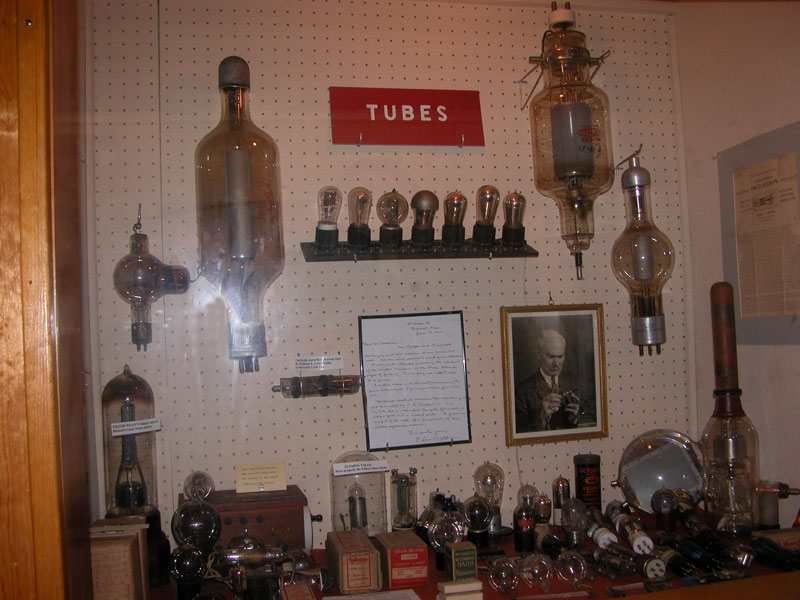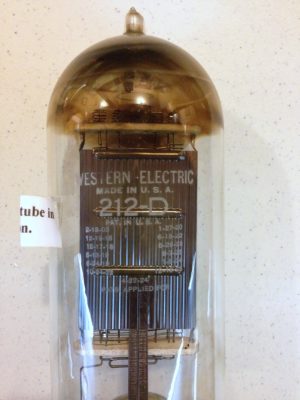 Looking in the left hand corner is a 212-D triode vacuum tube, which happened to have been the actual final amplifier tube of WEAN, Providence, which was in a penthouse on top of the Biltmore Hotel. You probably can’t see that card next to that big bottle, but that’s the Biltmore Hotel with the antenna towers on its roof. The transmitter was in a little building on the roof.
Looking in the left hand corner is a 212-D triode vacuum tube, which happened to have been the actual final amplifier tube of WEAN, Providence, which was in a penthouse on top of the Biltmore Hotel. You probably can’t see that card next to that big bottle, but that’s the Biltmore Hotel with the antenna towers on its roof. The transmitter was in a little building on the roof.
Professor E. Leon Chaffee, who was one of my teachers at Harvard Engineering School, was an eminent authority on radio in the early days. And in the Cruft Laboratory at Harvard he had the distinction of building the highest-power triode up to that time…and there is the actual triode on the pegboard to the left of the letter from Professor Chaffee to me. He gave the museum that 50-watt triode in 1966. And that is the world’s first 50-watt triode, so that’s quite an important, historic critter.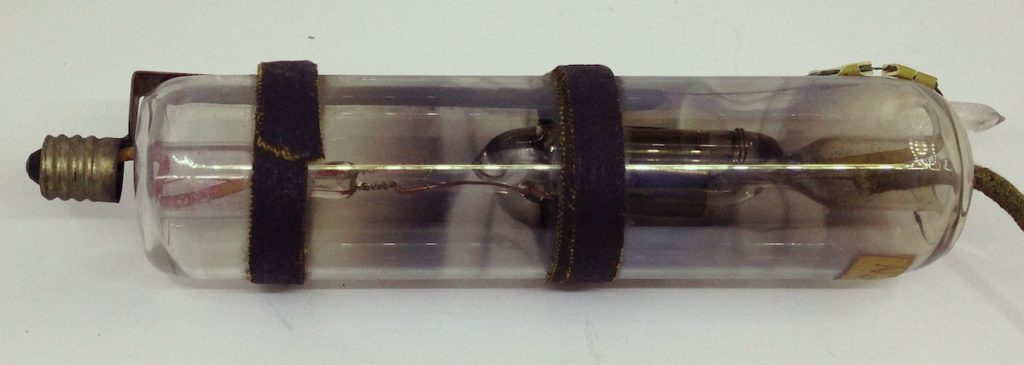
Fred – “Now, who developed, or is “invented” the right word, the radio tube?
Oh, well, that subject comes back at the far end down there…Armstrong’s window. We’ll talk about that.
Of course, Lee de Forest is the guy that actually put the grid…and he’s the gentleman in that picture…put the grid between the filament and the plate, making the triode vacuum tube. So, nobody’s arguing with Lee de Forest on that particular point. But the generation story is quite different, and that comes to Armstrong at the far end.
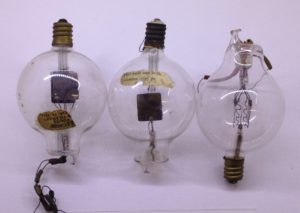 The spherical objects in the front here are Lee de Forest audions. They are the original triode vacuum tube, and de Forest, rightly, has claimed that invention.
The spherical objects in the front here are Lee de Forest audions. They are the original triode vacuum tube, and de Forest, rightly, has claimed that invention.
Fred – “When was that?”
1906. The date is somewhere around there. 1912-13, is when Armstrong discovered regeneration and de Forest went to war with Armstrong, saying, “Hey, you stole my idea…”, but history has shown that Armstrong was the originator, not de Forest. And de Forest lost quite a bit of face after that.
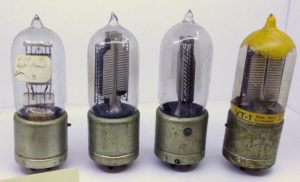 In World War I, vacuum tube radio exploded into use, and the VT-1, those little tubes that are leaning against the cartons, was the first military triode vacuum tube. And there are two in those two unopened cartons right there. The cartons are covered with signatures of eminent, early wireless people who came here at one of our first meets, and they signed these boxes.
In World War I, vacuum tube radio exploded into use, and the VT-1, those little tubes that are leaning against the cartons, was the first military triode vacuum tube. And there are two in those two unopened cartons right there. The cartons are covered with signatures of eminent, early wireless people who came here at one of our first meets, and they signed these boxes.
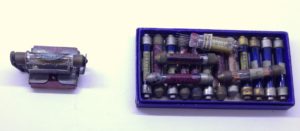 Jumping around, there are all kinds of interesting things in here. In a radio receiver you need a high resistance in the grid of the detector tube, and that high resistance had the name of a grid leak. And the grid leak was always bypassed with a little capacitor. And some wag, some amusing guy years ago, decided to make a grid leak drip pan (chuckle)…and down here, I don’t know as you can see it, but there’s the grid leak on the top with the drip pan hanging from it, and the capacitor that it bridges beneath.
Jumping around, there are all kinds of interesting things in here. In a radio receiver you need a high resistance in the grid of the detector tube, and that high resistance had the name of a grid leak. And the grid leak was always bypassed with a little capacitor. And some wag, some amusing guy years ago, decided to make a grid leak drip pan (chuckle)…and down here, I don’t know as you can see it, but there’s the grid leak on the top with the drip pan hanging from it, and the capacitor that it bridges beneath.
Fred – “What’s this one over here with the liquid in it?”
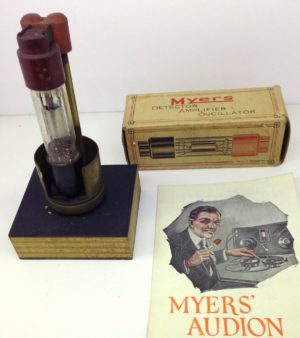 No, there’s no liquid in there. That’s a Myers tube. The man that made that was here at one of our early wireless meets back in the 1960’s. He was an interesting guy. There’s another Myers tube in the little carton on its side behind it. There are so many interesting things here.
No, there’s no liquid in there. That’s a Myers tube. The man that made that was here at one of our early wireless meets back in the 1960’s. He was an interesting guy. There’s another Myers tube in the little carton on its side behind it. There are so many interesting things here.
Fred – “Tell me a little bit about those wireless meets. Those were people who weren’t just hobby collectors…they knew what the electrons were doing in the instruments, right?”
Oh, absolutely. They were important people of history of radio. They would come up in those days…unfortunately those early guys are practically all deceased now. But most of them at one time or another came here, and they reveled in the things that they saw here.
Fred – “Because they knew what they were…”
Yes.
Fred – “…and understood their importance.”
Text from the transcript of a tour of New England Wireless & Steam Museum’s Wireless Building given by Robert W. Merriam on a winter day in 2012. Transcription by Craig H. Moody, K1CHM. Edited by Fred Jaggi.
